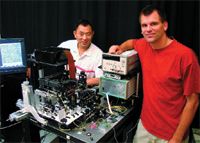Article
High-quality, real-time views of retina possible
Fort Lauderdale, FL-Researchers have developed a new-generation adaptive optics scanning laser ophthalmoscope (AOSLO) that can produce high-fidelity, real-time microscopic views of the living human retina. The device has been tested and found to be effective on both healthy and diseased eyes, said Yuhua Zhang, PhD, a researcher at the School of Optometry, University of California, Berkeley.
Fort Lauderdale, FL-Researchers have developed a new-generation adaptive optics scanning laser ophthalmoscope (AOSLO) that can produce high-fidelity, real-time microscopic views of the living human retina. The device has been tested and found to be effective on both healthy and diseased eyes, said Yuhua Zhang, PhD, a researcher at the School of Optometry, University of California, Berkeley.
In tests performed with a 6-mm pupil, the root-mean-square (RMS) aberration after adaptive optics correction was reduced on average from 0.4 to 0.1 μm. In addition, the use of low coherent light sources mitigated interference artifacts in the images and yielded high-quality images of the contiguous cone mosaic, Dr. Zhang said.

Understanding retinal disease
He explained that this technology should help improve the understanding and diagnosis of retinal diseases. High-resolution imaging could be used to study neovascularization in age-related macular degeneration and photoreceptors in retinal degenerative diseases such as retinitis pigmentosa and cone-rod dystrophy as well as individual RPE cells and blood flow in the smallest retinal capillaries.
Combining technologies
"The AOSLO combines two technologies, state-of-the-art adaptive optics technology and confocal scanning laser ophthalmoscopy, to provide cellular-level images of the living human retina," Dr. Zhang said. "Confocal scanning laser ophthalmoscopy fundamentally possesses the unique merits of confocal microscopy, such as enhanced imaging resolution and contrast, and is capable of optically sectioning the retina. But these benefits are robbed by the human eye's aberration. Adaptive optics, a technology borrowed from astronomy, automatically corrects the eye's aberrations, thereby correcting the blur and rendering sharp retinal images."
The initial version of the AOSLO, developed several years ago by Austin Roorda, PhD, associate professor of vision science at the University of California, Berkeley, was the first system to use adaptive optics to overcome the limits imposed by ocular aberrations and produce real-time, microscopic views of the living human retina with unprecedented optical quality and axial resolution, said Dr. Zhang, who works in Dr. Roorda's lab. With this device, the researchers obtained the first video-rate images of photoreceptors and blood flow in the human retina.
However, the system was both large and expensive, with the cost of one crucial component alone, the deformable mirror, reaching $60,000. Making a more compact and affordable system that could readily be used in clinical settings became the researchers' next objective.
The new-generation model of the AOSLO uses a micro-electro-mechanical deformable mirror (MEMS DM, Boston Micromachines Corp.), Dr. Zhang said.
The MEMS DM is the key to achieving their research goals, he continued. In order to achieve correction for all the aberrations in the eyes of 95% of the population over a 6-mm pupil, the ideal DM should have more than 100 actuators, a stroke of at least 10 μm, and be operable at frequencies above 30 Hz.
The MEMS DMs that meet this ideal requirement are close. They employ 140 actuators over a 4.4 × 4.4-mm optical aperture, and they have a stroke of 3.5 mm, just meeting the requirement as long as the defocus and astigmatism of the eye are corrected by other means. It potentially could be mass produced, thus lowering the cost.
Newsletter
Don’t miss out—get Ophthalmology Times updates on the latest clinical advancements and expert interviews, straight to your inbox.




